The Tunnel Rats

Charlie didn’t get much USO. He was dug in too deep, or moving too fast.
–Martin Sheen, Apocalypse Now
Nogales, Sonora, Mexico and Nogales, Arizona, USA are connected underground by a series of clandestine tunnels that link with the existing, legitimate stormwater drainage system.
Select DEA, HSI, and CBP agents stationed along the Southern borders of California, Arizona, and Western New Mexico specialize in finding and, when necessary, clearing such tunnels. Their work is important, hazardous, and not for the faint of heart.
Insurgent detainees at Camp Bucca, Iraq dug a tunnel from their tent–not to outside the wire, but rather to a guard post with a machine gun. They might have succeeded in their plan to gun down their guards (and any prisoners from opposing factions) once they got to the adjacent guard tower. When the tunnel was discovered, Security Forces personnel had to clear it.
As we speak, Israeli commandos may be clearing out a Hamas tunnel complex in Gaza.
Those military and law enforcement professionals can trace their heritage to the Tunnel Rats of Vietnam.
Would You Have What it Takes to be a Tunnel Rat?
The ‘Nam Tunnel Rats were a select group. Whether they volunteered or were voluntold, they were usually shorter, skinnier guys, for obvious reasons. 5-foot tall Kennith (sic) Ritchie, for example, had been a racehorse jockey before becoming a US Marine (Elaine Smith, “From Jockey to Tunnel Rat,” War History Online, 12 May 2016).
Less obvious in their selection process, be it a formal assignment or an or intuitive short-notice command decision, were a fell skill level and a fatalistic mindset.
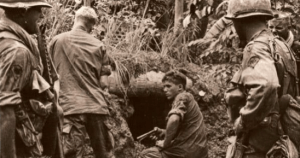
I’ve always felt that going down into a narrow dark rat and snake infested Viet Cong tunnel complex took more courage than standing up to a charge of heavy horse cavalry. When I served warrants for a living, being one of the shortest guys on the team, I occasionally poked my head up in an attic or crawled under a house trailer. When I did, I tried to draw inspiration from those Tunnel Rats who had it far, far worse than I.
Tunnel Rat: The Shooting Experience
One course of fire I’ve long dreamed of putting together would simulate that Tunnels of Cu Chi environment. Not for CosPlay, like SASS (Single Action Sport Shooting, aka Cowboy Action Shooting). Not for live action role play (what you see the Society for Creative Anachronism doing with padded wooden broadswords sometimes), although I guess the reasoning would be closer to LARPing. Nor for nostalgia, as most of those for whom such a course might take them “back to the day” are getting a little old to be crawling around on their hands and knees. Rather, it would be to gain a deeper, more direct understanding of the challenges some of our forefathers faced. I call it “Repeating the Feat.”
Setting up such a course would be involved, but not too difficult, if you had a plot of empty land and a Ditch Witch or similar trench excavating machine.
Course Design
The layout might look something like a Scrabble game from above.
Dig a series of interlocking trenches about 2 – 3 feet deep. They should be wider than your widest participant, at the shoulder.
Depending on how much land and time you have (and whether or not you have a life), you could add a few “rooms” to the layout. You could also make parts of the trench deep enough to crouch in, but participants should have to crawl most of the time.
Cover your network of trenches with plywood, cardboard, pallets with tarps, or whatever, except for a few select “entrances” from above.
You can place targets sideways at tunnel junctions or ends. You could even work out a more elaborate series of slits into which a target could be dropped, like a side-pivoting version of a pop-up (more correctly in this context, pop-down) target. In this regard it would be an unknown target course or Hogan’s Alley. Caution should be exercised not to let those operating your target systems, however elaborate (with strings and pulleys) or not (hand-dropped), be “downrange” of shooters in the tunnel complex.
Safety Considerations
Angles of Fire
Probably the biggest danger in live fire would be someone shooting at an angle above horizontal. Easy to do, considering most of the time the participant will be crawling along on his or her elbows, with a pistol in hand. Bullets angled upward could easily pierce the plywood / cardboard cover.
Mitigation could include:
- Dry runs with dry practice crawling above ground, to make firing at or below horizontal habitual before “going in.”
- Use of frangible ammo or Airsoft.
- Course layout ensuring that bullets will always be directed away from above-ground people and structures, even if they do pierce the plywood.
You could cover the plywood with a few feet of the dirt you excavated from the ditches you dug, but that might complicate rescue should it become necessary.
Cave-ins
The most common hazard in any excavation is collapse of a side wall. Depending on the soils composition, this could be more or less likely in your area. There are methods of shoring that may or may not detract from the realism, but the easiest way to guard against serious cave-ins would be to not dig your trenches too deep.
Making the plywood easy to pull up, and not letting people walk around (or resting anything heavy) too near the edges of the trenches, are other ways to ameliorate / mitigate the risks of trench wall collapse.
Ventilation
Between gun smoke and simply limited oxygen, it might be a good idea to install rain gutter downspouts, or the like, every so often in your layout.
Lead-free ammo can also reduce long-term hazards.
Wildlife
The ‘Nam Tunnel Rats had to deal with all kinds of deadly critters, but there’s no need for our participants to.
You should lift the covers and screen for snakes, spiders, and other of God’s creatures before each session.
Using plywood, rather than pallets with tarps, would provide fewer nooks and crannies for spiders. Regardless of your covers, it might be a good idea to leave them off the trenches when not in use.
To maximize the realism of your experience, you should do your runs through the tunnels during hours of darkness. If you live in an area where scorpions are a thing, you can screen for them beforehand with a UV light.
Equipment
Mandatory Equipment
- Angle-head GI flashlight.
- Field knife (preferably a Randall, Ka-Bar or M7 bayonet, but dad’s Ruana or Buck Bowie will do).
- Double hearing protection–muffs over plugs. Shooting without ear pro in confined spaces sucks (the voice of multiple experiences speaks).
- Eye protection. Muzzle blast will likely knock all kinds of particulates off the walls.
- A pistol. Preferably, a GI .45, but a Smith & Wesson Model 10 will do as long as you keep the forcing cone well ahead of your face. If you’re not sure what that means, read “Revolvers” in Mind the Gas Port.
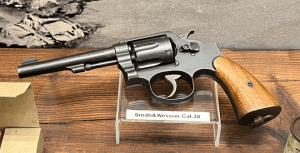
One account I read was of a tunnel rat who used his dad’s snubbie .38. Not so much for its handiness in tight quarters, but rather for luck. His dad had carried that gun as a cop without getting seriously hurt. His dad gave it to him when he deployed to ‘Nam.
Optional Equipment
- Cotton fatigues (or black pajamas; your preference)
- Nylon or canvas sided jungle boots (or rubber sandals)
- Bottle of LSA
- Packet of Lucky Strikes or Camels, zippo lighter
If you choose black pajamas, change “GI .45” in Mandatory Equipment to Tokarev T33, Makarov, or genuine Skorpion (not the modern-day CZ which is called a Scorpion), although as insurgents, the Charlies often resupplied with captured American and French equipment.
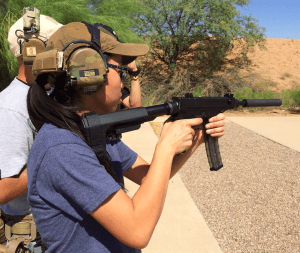
Some tunnel rats wore a headlamp. It was the old-fashioned kind, that looked like a satellite dish, about the size of a tea saucer. That kind of headlamp or light reflector was also worn by surgeons back in the day. Both professions–surgeons and tunnel rats–went inside to root out the bad stuff. Although I would accept one of those old-fashioned headlamps as “OEM” gear, a modern LED headlamp would be cheating yourself out of an authentic experience.
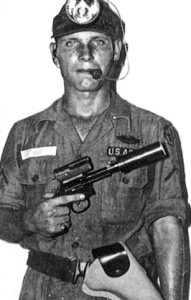
This experimental “tunnel exploitation kit” was allegedly field tested in 1966 and found wanting. I’ve seen other photos of a “can” on the muzzle of tunnel rat revolvers. My limited understanding is that revolvers cannot be effectively sound suppressed, owing to the gap between the cylinder and the forcing cone, but the can might be useful for flash suppression. The headlamp was operated by a bite switch. Not sure what kind of sighting system that was (perhaps something like an Armson OEG), but the iron handgun sights of the day were fairly useless in the dark.
According to photos I’ve seen, Tunnel Rats sometimes wore the steel “piss pot” helmet below ground. The piss pot was less prone to nose-diving in prone than the PASGT “Fritz” helmet that replaced it (we folded the collars of our flak jackets under to be able to see from prone).
The brim of a boonie hat could likewise block your vision. You could go with a ranger rag as a bandana, field cap turned backward, boonie with the front part of the brim tucked under against your forehead, or nothing at all on your head (other than eye and ear pro). But be mindful that one reason brimmed hats are mandatory in shooting schools is to keep brass from landing in the gap between the top of your eye protection and your forehead. In a 3’x3′ trench with plywood over the top, brass is much more likely to bounce back at you.
Maybe you could pin up the front of the boonie cap up, which would afford some protection from brass without blocking your vision.
Authentic Shooting Methods
I’ve not yet read (or if I did, it was decades ago and I’ve since forgotten) what shooting methods the Tunnel Rats used.
Most pistol shooting in those days, even on your feet, was one handed. With a flashlight in your support hand, that makes it even more likely you would have used one handed fire, likely from an elbow supported prone.
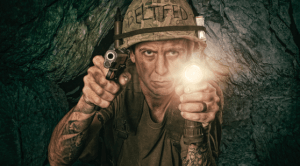
Rolling up on one’s side might be useful in some situations, especially at tunnel junctions.
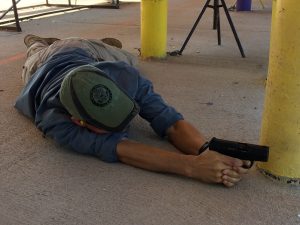
Supine might also be useful to free up the arms (rather than propping one’s self up on her or his elbows), or to shoot behind you if you somehow missed a threat as you crawled past and there is not room to turn around.
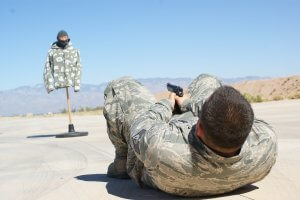
Both would probably increase the possibility of angling the shots upward, and shooting between your feet requires special range protocols.
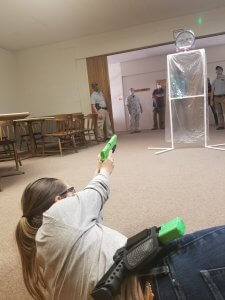
There are still some living men with genuine ‘Nam Tunnel Rat experience, leaning on bars in VFWs. For a beer or two they might be able to give you some firsthand accounts. They might even be willing to serve as technical advisors during your construction and operation.
Any Gender Would be Welcome
There were plenty of ladies in the tunnels of ‘Nam. They were “Charlies” (abbreviation of Victor Charlies, phonetic radio initials of the Viet Cong*), or NVAs (North Vietnamese Army). One of the most moving books I’ve read on the Vietnam war was Last Night I Dreamed of Peace, the diary of Dang Thuy Tram, a North Vietnamese battlefield surgeon who was killed supporting the VC in South Vietnam.
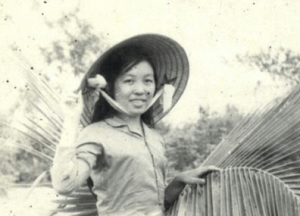
Some ladies might want to crawl through the course to gain understanding about warriors like Dang Thuy Tram. Others might want to learn about their Grandpa the USMC Tunnel Rat, and what he went through.
Additional Ambience Considerations
Generally, the Americans and ARVNs (Army of the Republic of [South] Vietnam) would roll a few grenades in before spelunking. Their fathers would hit up Japanese cave and tunnel complexes in places like Iwo Jima with flame throwers instead.
Flash bangs / artillery simulators would likely kick up a bunch of dust and perhaps weaken the walls of your trench. If you want to smell the smells, toss in a few small firecrackers before your run-through.
Sometimes, they would use smoke or tear gas grenades in Viet Nam to flush out the Charlies, or find additional entrances. We do NOT recommend using smoke, unless you have self-contained breathing apparatus, which would get hung up in there. Regular gas masks filter air but they do NOT replace missing oxygen that has been used by combustion or displaced by other gasses.
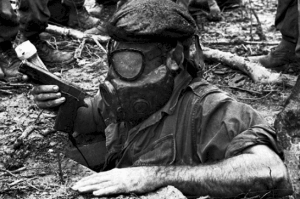
You might consider leaving a large bag of potatoes or rice right around the corner of a tunnel, or have one drop on participants from above. The idea is simply to have it be close. Participants can practice stabbing it a few times with their field knife. The real Tunnel Rats had to be prepared to do some wet work if they stumbled across someone–or got jumped–down there.
Why the Tunnel Rat Experience?
Setting something like this up would be a great deal of hassle for a series of experiences that would be transient at best. Why bother?
Heloderm teaches many esoteric skills I would describe at “niche” techniques: something useful only in limited circumstances, but very handy skills to have beforehand, should you find yourself in that situation. For example, Paul Castle taught Center Axis Relock (CAR) as a complete, go-to system for all situations. We teach CAR as a niche technique, say if you are moving on a rearward oblique and the threat is behind you off your support side; or if you are pinned in your automobile and bad guys are moving in for the kill from 7 or 5 o’clock.
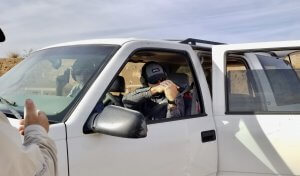
The Tunnel Rat Experience is not really to teach you niche techniques, unless you are in the business of conducting armed confined space rescues or clearing operations in cross-border tunnels, or in certain corrections environments.
But it would be more than just a lark, unless you run some sort of adult adventure theme park like Arizona Tactical Adventures.
Rather, to me, the Tunnel Rat Experience would be a way of appreciating the challenges faced by an under-appreciated generation of oft reluctant but willing warriors who went where Uncle Sugar sent them. They did some hard, nasty soldiering in service of their fellow Americans and the people of South Vietnam.
Question: How many ‘Nam vets does it take to screw in a lightbulb?
Answer: You couldn’t possibly know, man. You weren’t there.
Similarly, one day I’d also like to ride in an old B-17 or P-51 warbird, just to have some inkling of what the men of the Army Air Forces experienced in WWII, and what my dad experienced in Korea.
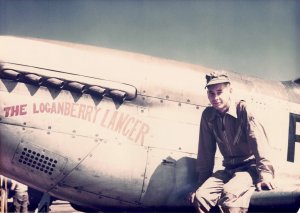
I don’t have many original ideas, but this concept is one. I’m sharing it, and my thoughts about how to execute it safely and successfully, with you, in case you have the means and wish to do so.
Any Takers?
Heloderm LLC has not yet set this course up. Currently, we lack the real estate and the trenching equipment to do so.
If you live in Baja Arizona (or even anywhere near So AZ), and have access to those two things (land and excavation equipment), I’d be more than happy to help you.
AZ state law (Arizona Revised Statutes, or ARS, 13-3107) specifically exempts “shooting in underground ranges on private . . . property” from the otherwise criminally proscribed activity of discharging firearms within the limits of any municipality or within a mile of any occupied structure.
Please reach out if we can offer advice or help you with your project in any way.
–George H, lead instructor, Heloderm LLC
The image at the top of this article is from the National Museum of the United States Army (thenmusa.org).
*Appendix: About “Charlie”
As if to confirm that history is written by the victors, it is now popular for historians to use the term National Liberation Front (NLF, or simply “the Front”) to describe all forces, North and South, which were opposed to the American supported South Vietnamese regime (see, for example, Mark Bowden’s excellent, well researched Hue 1968). The communist North Vietnamese regime used the NLF term to imply that all Vietnamese were or at least should be united in opposition to the Southern regime.
The reality was, as always, far more complicated.
US policy viewed the war between the North and South Vietnam as just that: two countries, with the one in the north attempting to invade the one in the south, as Saddam Hussein’s Iraqi troops invaded their neighbor to the south, Kuwait, on 02 Aug 1990. The main reason we were there, interfering in their war, was because we viewed it as a battle between the forces of democratic government on one hand, and world-wide communist domination on the other.
When assessing the enemy, the US military differentiated between irregular (now called “insurgent”) forces in South Vietnam, the VC, and regular army (NVA) troops from the north. While harboring great respect for the tenacity, resilience, and fierceness of VC irregulars, the US military thought that NVA regulars were generally better supplied and more professional soldiers.
This understanding was, in turn, a byproduct of their own US military heritage. The US had long spurned large standing armies between wars (this did not change till after WWII). Instead, they relied on a small cadre of highly trained, dedicated professional soldiers to hold fast in the beginning of a war until sufficient reserves could be mobilized to turn the tide (that’s what happened, for example, at Corregidor in 1941 – 42).
On 05 July 1814, US General Winfield Scott’s highly trained forces advanced on the British on the west bank of the Niagara River. They were not dressed in the blue uniforms of the regular Army, so the British commander, General Phineas Riall, assumed they were less thoroughly trained militia. He expected them to break and run after only a few dustings of cannon fire. Upon seeing their continued, orderly, well-disciplined advance, Riall famously exclaimed, “Those are Regulars, by God.”

“Regulars, by God” remains the motto of the 6th US Infantry Regiment to this day.
But in Vietnam, the distinction between regulars and irregulars was somewhat blurred. NVAs in South Vietnam often fought using guerrilla tactics. The VC were trained, supplied, and supported by the north.
Anti-war activists claimed that there was zero distinction. They said the US was interfering in a civil war, Vietnamese internal affairs, and that we made up the term “Viet Cong” (literally, Vietnamese Communist) to paint the war in democracy vs socialism, rather than Vietnamese nationalist, terms.
Viet Cong is a term the Vietnamese themselves coined decades before the US involvement to describe communist Vietnamese revolutionaries, just as Trung Cong meant Chinese communist revolutionaries. For details, see Brett Reilly’s excellent article “The True Origin of the Term Viet Cong” in The Diplomat.
While not all of the guerrilla troops in the south were card-carrying communists–many were more concerned about expelling foreign invaders and their puppets–communist indoctrination was a huge part of their recruitment and propaganda efforts. North Vietnam was a communist regime, and ever since North Vietnamese tanks rolled across South Vietnam in 1975, all of Vietnam has had a communist government.
The grunts in the bush called them all–Viet Cong, Viet Minh, Viet Quoc, NVA–“Charlie,” just as their fathers had called the Wehrmacht soldiers “Fritz,” whether or not they were card-carrying Nazis. The real reason “NLF” and “the Front” is replacing “VC” and “Charlie” in revisionist histories is because of the woke assumption that the terms are pejorative or even racist, and we are all held in fear of even appearing to be the later.
It’s ridiculous.
“Charlie” is nothing more than a phonetic abbreviation. “Cong” is a Vietnamese term describing communists. Well, they were. And still are.
Was “Fritz” a racist term? White people used it to describe white Germans. Seems to me that makes Fritz nationalist, not racist.
Was Fritz used pejoratively? No doubt it was. We can perhaps forgive a paratrooper who dropped in behind Normandy and later froze his butt off at Bastogne (“the Bulge”), perhaps even liberated a concentration camp or two, for not always speaking highly of those who created complex, highly efficient death factories for Jews, Russians, Gypsies, and political opponents, and frequently tried to kill him.
“Jap” is merely an abbreviation of “Japanese.” Japanese refers to a specific nationality–the nation that bombed Pearl Harbor and raped their Asian neighbors in Nanging–not to Asians in general. But because it was often used pejoratively by many who no doubt held racist anti-Asian sentiments, you can’t say Jap today. We all know that it is inherently racist to use one or two syllables when one can use three or more.
During the GWOT, Global War on Terror (which is ongoing but not called that anymore), a lieutenant called me out for telling trainees deploying to Iraq that “While Ahmed is pinning you down behind your cover, Omar will flank you to negate it.” He said I should have used “insurgent number one and insurgent number two” instead. Again with the too-few syllables. Apparently, using names common in the region they were deploying to was not respectful enough to those who wish us dead. I can’t imagine anyone referring to Nazis as “Fritz” (or even “the Hun”) during World War Two getting flak from his superiors for not being politically correct enough when referring to our enemies. But then, we were serious about defeating existential threats in the 1940s.
The same assumption is being applied to American soldiers in Southeast Asia having called their enemies Charlie. No doubt many of our GIs–White, Black, Brown, and Red–harbored anti-Asian prejudices. The term Charlie, like any descriptor, could be used pejoratively, but as often as not it was used with respect. I imagine that many veteran Tigerland instructors with MACV (Military Assistance Command Vietnam) patches on their right (“been there, done that”) sleeves prepared recruits for their impending Indochinese ordeal with phrases like “You try that over there, and Charlie’s gonna have you for breakfast.” Which anyone with any brains knows is a common colloquialism for defeating one in battle, not a blanket assertion that Asians, or even communist Asians, practice cannibalism. But we live in an era when intelligent people are being silenced to avoid erroneous offended inferences by stupid people.
When I went through Army PNCOC (RECONDO) in 1983, several of our instructors had unit patches from Vietnam on their right sleeves. When they spoke of Charlie, it was never with disrespect.
Indeed, I’m convinced that the reason returning ‘Nam vets didn’t break the pencil necks of skinny hippies who spat on them and called them “baby killers” was partially because it was illegal, but mainly because it would have been too easy.
Charlie, in contrast, had been a worthy adversary.
